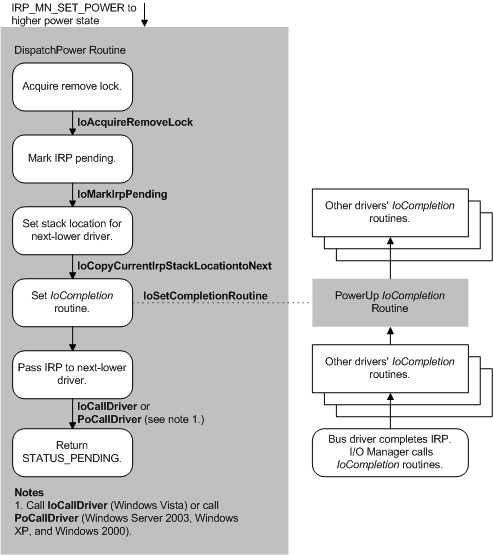Handling Device Power-Up IRPs
Device power-up IRPs specify IRP_MN_SET_POWER and a device power state that requires more power than the current device power state. Typically, a power-up IRP specifies the device working state PowerDeviceD0.
Requests to power up a device must be handled first by the underlying bus driver for the device, and then by each successive driver going back up the stack.
The following figure shows the steps involved in handling a power-up IRP.

When handling an IRP_MN_SET_POWER request for power-up, a function or filter driver must:
Call IoAcquireRemoveLock to ensure that the driver does not receive an IRP_MN_REMOVE_DEVICE request while handling the power-up IRP.
If IoAcquireRemoveLock returns a failure status, the driver should not continue processing the IRP. Instead, beginning with Windows Vista, the driver should call IoCompleteRequest to complete the IRP and then return the failure status. In Windows Server 2003, Windows XP, and Windows 2000, the driver should call IoCompleteRequest to complete the IRP, then call PoStartNextPowerIrp to start the next power IRP, and then return the failure status.
Call IoMarkIrpPending to mark the IRP pending.
Call IoCopyCurrentIrpStackLocationToNext to set the IRP stack location. A driver must not call IoSkipCurrentIrpStackLocation if it sets an IoCompletion routine.
Call IoSetCompletionRoutine to set a power-up IoCompletion routine.
When handling a device power-up IRP, the driver should set an IoCompletion routine to restore context, release the remove lock, and perform other required tasks after the IRP is complete and the device powers on. The driver should not restore context before the IRP has completed. For more information, see IoCompletion Routines for Device Power IRPs.
Call IoCallDriver (in Windows 7 and Windows Vista) or PoCallDriver (Windows Server 2003, Windows XP, and Windows 2000) to pass the IRP to the next-lower driver. The IRP must travel all the way down the device stack to the bus driver. Only the bus driver is allowed to complete the IRP.
Return STATUS_PENDING.
When the bus driver receives the IRP, it should first check to ensure the device is still present and has not been removed or replaced while asleep. If the device is no longer present, the bus driver should call IoInvalidateDeviceRelations on the parent device to notify the Plug and Play manager that the device has disappeared. In this situation, the bus driver can fail the device power-up IRP.
If the device is still present, the bus driver then performs the tasks required to return the device to an operating condition, calls PoSetPowerState to inform the power manager of the new device power state, and completes the IRP (IoCompleteRequest). If drivers have queued I/O while the device was sleeping, or if the device requires inrush power, the bus driver applies power to the device. Otherwise, the bus driver applies power as soon as it has to communicate with the device.
For a list of best practices to achieve fast startup times from power-off, standby, and hibernation states, see Improving System Startup Performance.
Feedback
Coming soon: Throughout 2024 we will be phasing out GitHub Issues as the feedback mechanism for content and replacing it with a new feedback system. For more information see: https://aka.ms/ContentUserFeedback.
Submit and view feedback for